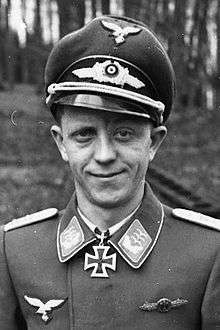Walter Matoni
| Walter Matoni | |
|---|---|
 Walter Matoni | |
| Born |
27 June 1917 Duisburg |
| Died |
26 June 1988 (aged 70) Frankfurt |
| Allegiance |
|
| Service/branch |
|
| Years of service | ?–1945 |
| Rank | Major |
| Unit |
JG 27 JG 26 JG 11 JG 2 |
| Commands held |
II./JG 2 I./JG 11 |
| Battles/wars | |
| Awards | Knight's Cross of the Iron Cross |
Walter Matoni (27 June 1917 – 26 June 1988) was a German Luftwaffe ace and recipient of the Knight's Cross of the Iron Cross (German: Ritterkreuz des Eisernen Kreuzes) during World War II. The Knight's Cross of the Iron Cross was awarded to recognise extreme battlefield bravery or successful military leadership.
Career
Matoni was born on 27 June 1917 in Duisburg. Feldwebel Matoni was assigned to 9./Jagdgeschwader 27 (JG 27—27th Fighter Wing) in the summer of 1940 and his first claim, a Hawker Hurricane followed on 30 September.[Note 1] During mid 1941 Matoni operated over Russia and claimed three victories (Two DB-3's and an R-10). On 17 August 1941 Feldwebel Matoni was posted to 5./Jagdgeschwader 26 (JG 26—26th Fighter Wing) based on the Channel front. He was soon transferred to 7./JG 2 (JG 2—2nd Fighter Wing) in September.
He was badly wounded in aerial combat resulting in a lengthy convalescence, following which he served as an instructor with Jagdgruppe West from October 1942 to February 1943, when Leutnant Matoni returned to II./JG 26.
He shot down a Supermarine Spitfire on 17 June as his fifth victory. On 31 August, Oberleutnant Matoni's Focke Wulf Fw 190 A-5 was hit and he was wounded by return fire from United States Army Air Forces (USAAF) B-17 bombers, force-landing at Montdidier. In December he claimed a Spitfire near Boulogne on 21 December as his 8th victory.
In an action against USAAF B-26 twin-engine bombers on 14 January 1944 Matoni shot down a Spitfire escorting the bombers, probably flown by Austrian-born S/L. Franz Colloredo-Mansfeld DFC (3 destroyed) of No. 132 Squadron RAF, who was killed. On 24 February Matoni shot down a USAAF B-24 four-engine bomber near Frankfurt for his 13th and JG 26's 2,000th victory. Matoni was appointed Staffelkapitän (squadron leader) 5./JG 26 in February 1944, and on 10 May was awarded the German Cross in Gold for 20 victories. On 15 August 1944, Hauptmann Matoni was appointed Gruppenkommandeur (group commander) of I./Jagdgeschwader 11 (JG 11—11th Fighter Wing) before being appointed Gruppenkommandeur of I./JG 2 on 24 September.
On 5 December, Matoni was so seriously injured in a crash he was unfit to undertake any further combat flying. Despite this, he was appointed Gruppenkommandeur of II./JG 2 in January 1945 until 28 February. Matoni was awarded the Knight's Cross of the Iron Cross on 16 December 1944.
Walter Matoni was credited with 34 victories in over 400 missions. He recorded three victories over the Eastern Front, and of 31 victories claimed over the Western Front, 14 were four-engine bombers.
He ended the war at the Fighter Pilot's rest-home at Bad Wiessee. Matoni died on 26 June 1988 in Frankfurt.
Just three years before his death, Matoni appeared on the British television show This Is Your Life on the 8 May 1985, the 40th anniversary of the German capitulation. He was guest on the Johnnie Johnson episode, celebrating the RAF ace' life. Matoni's presence owed to a British media-created legend that Johnson personally challenged the German to a duel over Normandy.
Awards
- Flugzeugführerabzeichen
- Front Flying Clasp of the Luftwaffe
- Ehrenpokal der Luftwaffe (31 March 1944)
- Iron Cross (1939)
- 2nd Class
- 1st Class
- Wound Badge (1939)
- in Black
- in Silver
- German Cross in Gold on 1 October 1944 as Oberleutnant in the 5./Jagdgeschwader 26[1]
- Knight's Cross of the Iron Cross on 16 December 1944 as Hauptmann and Gruppenkommandeur of the II./Jagdgeschwader 2 "Richthofen" [2][Note 2]
Notes
- ↑ For an explanation of Luftwaffe unit designations see Organisation of the Luftwaffe during World War II.
- ↑ According to Scherzer as Gruppenkommandeur of the I./Jagdgeschwader 2 "Richthofen".[3]
References
Citations
Bibliography
- Fellgiebel, Walther-Peer (2000) [1986]. Die Träger des Ritterkreuzes des Eisernen Kreuzes 1939–1945 — Die Inhaber der höchsten Auszeichnung des Zweiten Weltkrieges aller Wehrmachtteile [The Bearers of the Knight's Cross of the Iron Cross 1939–1945 — The Owners of the Highest Award of the Second World War of all Wehrmacht Branches] (in German). Friedberg, Germany: Podzun-Pallas. ISBN 978-3-7909-0284-6.
- Obermaier, Ernst (1989). Die Ritterkreuzträger der Luftwaffe Jagdflieger 1939 – 1945 [The Knight's Cross Bearers of the Luftwaffe Fighter Force 1939 – 1945] (in German). Mainz, Germany: Verlag Dieter Hoffmann. ISBN 978-3-87341-065-7.
- Patzwall, Klaus D. and Scherzer, Veit (2001). Das Deutsche Kreuz 1941–1945 Geschichte und Inhaber Band II. Norderstedt, Germany: Verlag Klaus D. Patzwall. ISBN 3-931533-45-X.
- Scherzer, Veit (2007). Die Ritterkreuzträger 1939–1945 Die Inhaber des Ritterkreuzes des Eisernen Kreuzes 1939 von Heer, Luftwaffe, Kriegsmarine, Waffen-SS, Volkssturm sowie mit Deutschland verbündeter Streitkräfte nach den Unterlagen des Bundesarchives [The Knight's Cross Bearers 1939–1945 The Holders of the Knight's Cross of the Iron Cross 1939 by Army, Air Force, Navy, Waffen-SS, Volkssturm and Allied Forces with Germany According to the Documents of the Federal Archives] (in German). Jena, Germany: Scherzers Militaer-Verlag. ISBN 978-3-938845-17-2.
- Spick, Mike (1996). Luftwaffe Fighter Aces. New York: Ivy Books. ISBN 978-0-8041-1696-1.
External links
| Military offices | ||
|---|---|---|
| Preceded by Oberleutnant Hans Schrangl |
Commander of I. Jagdgeschwader 11 15 August 1944 – November 1944 |
Succeeded by Hauptmann Bruno Stolle |
| Preceded by Hauptmann Georg Schroder |
Commander of III. Jagdgeschwader 2 January 1945 – February 1945 |
Succeeded by Hauptmann Fritz Karch |